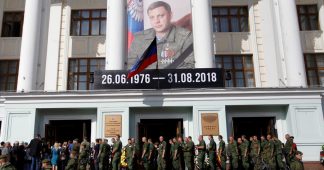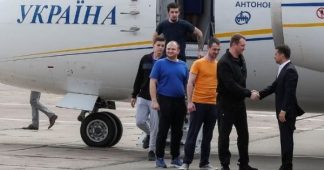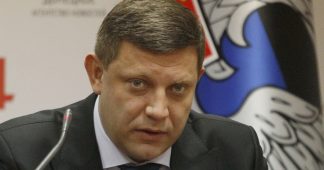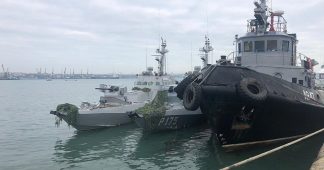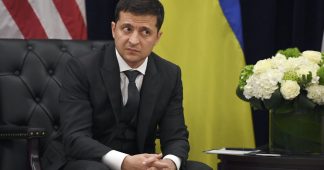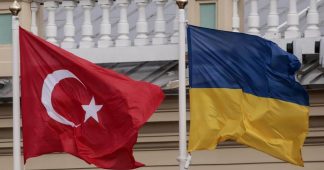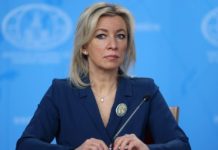By
Numerous statements by Ukrainian and Russian officials reported this Easter Sunday bode ill for hopes of diminishing tensions in Eastern Ukraine. Growing indications of impending intervention by the Pentagon and NATO make the situation yet more grim. U.S. European Command has raised its Ukraine watch level from possible crisis to potential imminent crisis, the highest level, according to Stars and Stripes.
The past few days have witnessed a phone conversation between President Joe Biden and his Ukrainian counterpart Volodymyr Zelensky and a similar exchange between Defense Secretary Lloyd Austin and his, Defense Minister Andrii Taran. In both instances the American officials assured their Ukrainian allies of American support not only in their steadily mounting conflict with the Donetsk and Lugansk republics in the Donbass in what was formerly Eastern Ukraine, but with its war of words, and veiled words of war, with Russia which borders the two republics.
Ukraine reports a government soldier being killed in an explosion and Donetsk states a child was killed and a woman wounded in an attack in its territory by a Ukrainian drone strike.
The deputy speaker of Russia’s upper house of parliament, Konstantin Kosachev, evoked the death of the child to warn the NATO and European Union nations in Europe that their silence on the Ukrainian government’s resumption of shelling in the Donbass is providing the Kiev government carte blanche to continue and to escalate the current conflict into a prelude to all-our war. A war, moreover, on the Russian border, one that it’s difficult to imagine Moscow being able to stand aloof from for long. His words included, “Yesterday, for the first time since July 2020 a Ukrainian shelling of the DPR [Donetsk People’s Republic] was conducted and a six-year-old child died,” and he bemoaned the fact that “there is no word about this” from Ukraine’s and Russia’s partners in the Normandy Contact Group, France and Germany. (The Normandy Format was established in 2014 when fighting in the Donbass erupted in order to deescalate the conflict and reach a peaceful settlement between its participants.)
Instead the French-German statement emphasized “support for the sovereignty and territorial integrity of Ukraine within its internationally recognised borders,” a reference to Donetsk, Lugansk and Crimea, and added: “We are closely monitoring the situation and in particular Russian troop movements, and call on all sides to show restraint and to work towards the immediate de-escalation of tensions.” A more partisan appraisal is hard to imagine, and is yet more disturbing as it casts Russia in the role of potential aggressor against Ukraine as well as siding with Kiev in its armed conflict with the Donbass republics.
The Ukrainian government is proving increasingly successful in its endeavors to recruit the U.S. and NATO into the conflict on its side and to direct their attention toward Russia as an adversary.
The government press agency TASS paraphrased the above-Russian senator reflecting that the catastrophe in Eastern Ukraine could have been prevented at its inception in 2014 “if Europe had refused to accept the coup d’état in Ukraine or had demanded the new authorities ‘fully observe common European values in regard to its citizens.’”
The same source cited the speaker of the lower house of the Russian parliament – the Russian State Duma – Vyacheslav Volodin, who in the same tone of urgency and condemnation his colleague in the upper house adopted toward France and Germany, wrote this about Ukrainian authorities’ current behavior:
“The Ukrainian leaders’ rhetoric has gone too far, adding to the tensions and aggravating the conflict. It is fraught with the most serious consequences. What are Ukrainian officials saying? Do they call for the settlement of the situation? No. Their actions are geared to intimidate people, to fan tensions in the region.”
The two Russian parliamentarians doubtlessly reflect the position of the government as a whole; one which reveals the highest degree of alarm over prospects of the war near Russia’s border affecting its national security as well.
In equally blunt language the lawmaker added, “one should bear in mind that not everything that is advantageous for the United States is in Europe’s interests.” President Joe Biden’s relation to Ukraine before but particularly since the coup and resulting war of 2014 was sufficient indication of what to expect from Washington once he entered the White House. Such apprehensions have not proven unwarranted. The Russian speaker extended his indictment of U.S. responsibility for the current crisis by accusing the U.S. of doing nothing in the seven years since the American-backed coup there to assist the nation’s economy. “The country has lost its sovereignty in practically all areas,” he added, emphasizing that not even a single batch of the coronavirus vaccine has been sent to Ukraine: “If the United States charges even its NATO partners for protection, it will demand trice as much from Ukraine.”
Shifting his attention to Kiev, he said: “Before it is too late, Ukrainian leaders must spare no effort to implement the Minsk accords. Stop escalating the situation in Donbass if you don’t want to finish your political careers in the Hague.”
While the Russian legislator lambasted Washington, a major Ukrainian official appealed to it to enter the fray. The country’s deputy prime minister and the head of the ominous-sounding Ministry of Reintegration of Temporarily Occupied Territories of Ukraine – that means of course not only Donetsk and Lugansk but Crimea, now part of Russia, as well – Oleksiy Reznikov, recently advocated that the U.S. join the Normandy Format and the Trilateral Contact Group on Ukraine, the latter currently consisting of Ukraine, Russia and the Organization for Security and Co-operation in Europe, also created seven years ago. He said: “A discussion – at the level of Ukraine – [with the] participation of the United States [regarding the Donbass] is absolutely possible and acceptable at different levels….[The] United States…can begin to work both in the Normandy format and at the level of ambassadors and coordinators of the Trilateral Contact Group.”
The U.S. joining the Normandy Contact Group would stack it four to one against Russia, with three members of the NATO Quad allied with Kiev against it.
On the occasion of the 72nd anniversary of NATO on April 4, while the Russian foreign ministry accused NATO’s increased arms spending of fueling a global arms race, Ukrainian President Zelensky called on the military bloc to grant his country a Membership Action Plan, the final stage to full NATO membership, one used by the sixteen countries that have joined the alliance since 1999. To highlight Ukraine’s value to Washington and NATO, Zelensky boasted of the fact that Ukraine this year will engage in fifteen multinational military exercises abroad and host nine at home. The latter will include this year’s iteration of Rapid Trident, Sea Breeze, Cossack Mace, Warrior Watcher, Riverine, Three Swords and Silver Sabre.
The Sea Breeze multinational naval drills will be the twenty-first iteration of the exercise, one which includes the participation of U.S. anti-missile Arleigh Burke-class guided-missile destroyers and is employed to integrate U.S. and NATO military forces in the Black Sea for operations in the region. Until 2014 they were based in Crimea. In 2006 the theme of the war games was to “simulate the defence of a peninsula caught between a totalitarian state and a democratic one.” It was cancelled by the Ukrainian government of pro-Western President Viktor Yushchenko because of local anti-NATO protests.
The Commander-in-Chief of the Armed Forces of Ukraine, Colonel-General Ruslan Khomchak, made this offer to NATO:
“We effectively utilize NATO partnership tools and mechanisms to support…engagement with the Alliance, that has progressed even further with Ukraine’s recognition as an Enhanced Opportunities Partner. Ukraine is now one of six Enhanced Opportunities Partners, alongside Australia, Finland, Georgia, Jordan and Sweden. And we work on particular practical measures to add practical value to such cooperation format.”
He reminded NATO that Ukraine has supplied the military bloc with troops for Kosovo and Afghanistan (he didn’t mention to the U.S. in Iraq as well) and pledged to contribute to the NATO Mission in Iraq and NATO Operation Sea Guardian in the Mediterranean Sea, such efforts contributing to “reaching military criteria of a full-fledged NATO membership.” The quid pro quo will be NATO getting more involved in Ukraine.
Roman Mashovets, Deputy Head of the Office of the President of Ukraine on National Security and Defense and the Defense Industry, recently met with the head of the NATO Representation to Ukraine, Alexander Vinnikov, and advocated that NATO hold joint air patrols in Ukrainian air space. The Ukrainian press reported that “Ukraine has offered NATO to hold joint military exercises in response to Russia’s moves to amass troops near the Ukrainian border.” That is as direct a call for NATO air and ground forces to be deployed against Russia as can be made.
The NATO envoy was in accord. Vinnikov, again according to a Ukrainian news source, “expressed condolences over Ukraine’s losses in recent weeks in the fight against Russian aggression in Donbas,” and stressed that Ukrainian government assessments of the fighting in the east of the country “will be passed to the Alliance’s headquarters in Brussels.”
Efforts of the sort detailed above indicate a clear intent to involve the U.S. and NATO in Ukraine’s worsening confrontation with not only the Donbass but Russia as well. They may herald as direct a clash between the first two and the last as the world has yet seen.
Published at antibellum679354512.wordpress.com
